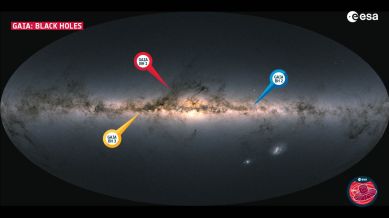[ad_1]
A new “sleeping giant” black hole has been discovered in the Milky Way and it is the largest of its kind discovered in the galaxy.

The European Space Agency on Tuesday said scientists uncovered a “sleeping giant” black hole in the constellation Aquila less than 2,000 light-years from our planet. It is nearly 33 times the mass of our Sun, and this is the first time such a big black hole of stellar origin this big has been discovered in the Milky Way.
In fact, black holes of this type have only been discovered in very distant galaxies and the new discovery challenges scientific ideas about how massive stars come about and grow. In a black hole, matter is so densely packed that nothing can escape its colossal gravitational pull, not even light.
You have exhausted your
monthly limit of free stories.
Read more stories for free
with an Express account.
Invest in Democracy. Invest in an Indian Express subscription.
This premium article is free for now.
Register to read more free stories and access offers from partners.
Invest in Democracy. Invest in an Indian Express subscription.
This content is exclusive for our subscribers.
Subscribe now to get unlimited access to The Indian Express exclusive and premium stories.
Most stellar-mass black holes that scientists discovered are sucking in matter from a nearby star. This material falls into the black hole at such high speeds that it heats up and releases X-ray radiation.
Sometimes, black holes do not have any stars close enough for them to steal matter from and this means they do not generate any light, making them extremely difficult to spot. Astronomers call these black holes “dormant.”
They discover such black holes by carrying out complex tests on data of motions of billions of stars to see if anything is out of the ordinary. An invisible “dormant” black hole can affect the movement of stars that are close enough to it.
While looking for such “odd stars,” researchers discovered an old giant star in the constellation Aquila. They analysed a wobble in its path in detail and found that it was locked in an orbital motion with a dormant black hole with exceptionally high mass. This is the third dormant black hole discovered using the space agency’s Gaia space observatory and has been named “Gaia BH3.”
The results of the study have been published in the journal Astronomy & Astrophysics.
© IE Online Media Services Pvt Ltd
First uploaded on: 16-04-2024 at 13:21 IST
